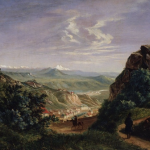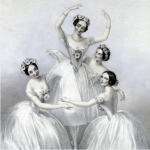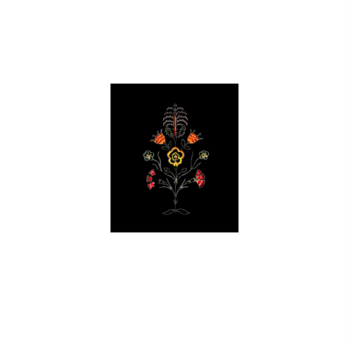A HEROINE OF OUR TIME
Spring 1837.
Along the boulevard, young men in love, jealous of their beauties in advance, drafted battle plans for conquests of the heart. [1] Here, in the evening, Circassians brought their best horses, and the Armenians spread out their most expensive wares on square carpets. A boulevard like this had its own peculiar charm, and one could admire the beautiful faces under the hats of the latest fashion. You would meet young fashionables with guard lapels, or wearing handsome business coats with lorgnettes and whips, donning hairstyles à la mougick à la effarouché. There were Circassians in shaggy caps, armed from head to toe, as if for a raid, or a family of landowners who had been traveling for two months from afar, bringing with them the belated styles and dialect of their district. Here was where the restaurant (the only one in Pyatigorsk,) was located. In one room, one might find men talking peacefully with cigars, wearing Turkish fezzes on shaved heads. In the other room, there would be crowds of young people, laughing noisily, and encircling the billiards and card tables. The bandaged wounded, pale, emaciated, with often mutilated faces, presented a strange contrast to the blooming faces and the babble of fluttering youth. This collection of outfits, crutches, and colored bandages, among the laughter of the yearning young that convened under the trembling flicker of the moon, was something like a scene from the popular ghost ballets.[2] A danse macabre, where the dead rose from their graves wearing the costumes in which they were buried.[3]
Those who have not been to Pyatigorsk may imagine this boulevard like Tverskoy in Moscow, or the one which surrounds the Admiralty in St. Petersburg, but this was not the case. There were no fountains or statues here, just an alley of trimmed linden trees that cut the entire length of the city and led to the mineral water springs. Instead of plastered walls, one saw wild cliffs at a height above the city, sticking out like teeth in sylvan lips. Sometimes the majestic Beshtau rested proudly in the blue of the sky, and sometimes it burrowed into the fog.[4]
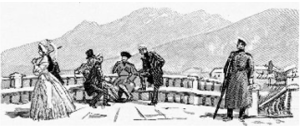
Pyatigorsk c. 1830s.[5]
An acquaintance whom Helena Andreevna met in Pyatigorsk, an eloquent, exiled, young officer named Mikhail Lermontov, said the five-peaked Beshtau was like “the last cloud of a dispersed storm.” Mount Mashuk, which rose in the north, he said, was “like a shaggy Persian cap concealing this part of the horizon.” To the east, the view was even cheerier, as the clean new town below was a colorful spread. The multilingual crowds babbled as much as the medicinal fountains, while in the distance, the “massive amphitheater of mountains,” as Lermontov called them, grew “ever bluer and mistier,” while on the fringe of the horizon, Mount Kazbek began the stanza of snow-capped peaks which ended in an exclamation with the twin-peaked Elbrus.[6]
A dashing hussar of the Leyb Gvardiya, Lermontov had fiery southern eyes, and a vaguely “Asian face.” Though not particularly handsome, his poetry was otherworldly, watercolors of passion on the frontiers of the Empire using the brush of Byron and the paints of Pushkin. He was, in the words of Helena Andreyevna, “clever as a devil.”[7] Their writings were somewhat similar, as Lermontov, too, would meet with some of the Decembrists at this time, and use this as material for his work.[8] Both would also write stories with similar themes set in this region, Lermontov with “Princess Mary,” and Helena Andreyevna with “The Medallion,” which told of Prince Yuryevich’s frivolous attitude towards the love of a seventeen-year-old girl.[9]
Helena Andreevna was certainly aware of such a love, and intimately, for it seems that Lermontov had been careless with the affection of her cousin, Katerina Sushkova. Helena Andreyevna knew this because it was the “secret story” that Katerina wrote in her diaries. The story, according to Katerina, went like this:
Six years earlier, when Katerina lived in Moscow, she charmed a rich young prince named Aleksei Aleksandrovich Lopukhin. The prince’s father, however, was against their marriage because of their age difference (she was eighteen while he was twenty,) and Katya’s meager fortune. She felt neither love for Aleksei Aleksandrovich, nor disgust for him. She initially only wanted to marry him for his “five thousand souls,” but since he was also handsome and clever, she ended up genuinely liking him too.[10]
She became extremely friendly with his cousin Alexandrina Vereshargina, who, it seemed, did not hear a soul in Katerina. So, in the spring, she left Moscow. Aleksei Aleksandrovich swore to her that he would wait for centuries if she promised him that same loyalty. Less than six months later, Vereshargina wrote to Katya that Aleksei Aleksandrovich’s father had died, and he wanted her to come to St. Petersburg. Katerina (expecting an engagement) agreed, and their reunion was very tender! Marya Vasilievna Bekleshova (her aunt) was ill, so Aleksei Aleksandrovich did not immediately announce his intentions. One day the prince brought a friend with him, Lermontov, a fellow student from Moscow University. As the days went on, Lermontov’s appearance was more frequent. Katerina treated him as a future relative and encouraged him to continue writing poetry, but Lermontov (who was sixteen) thought she treated him like a child. Lermontov continued to visit her, while visits from Aleksei Aleksandrovich were increasingly less frequent. Noticing that “some kind of cloud darkens his soul,” Katerina interrogated Aleksei Aleksandrovich, but he remained silent and made excuses by invoking the recent loss of his father.
Two months passed. Marya Vasilievna recovered, yet Aleksei Aleksandrovich still did not propose. He was silent and noticeably colder with Katerina. Lermontov, meanwhile, surrounded her with all his nets. He poured his sad out into his prose and poetry, and, finally, revealed to her that the day that she and Aleksei Aleksandrovich were married, would also be his last day. Katerina preferred Aleksei Aleksandrovich before, but now her head was spinning! She even stopped caring that the prince was cold to her, and she devoted herself completely to Lermontov who knew exactly how to entangle her soul. He used every weapon in his arsenal of charm to seduce her and prove to her how little the prince was worthy of her! He showered her with elegies and poems; he made her laugh and touched her. He succeeded! Katerina fell in love with him with all the passion of first reciprocity. This was a time when seduction and “conquest” occupied Petersburg society, with Les liaisons dangereuses and other “dangerous novels,” being fashionable templates for romance.[11]
Aleksei Aleksandrovich exited her life without saying goodbye. Katerina did not even grieve for him. Lermontov was just as passionate for the rest of the winter. Spring called him away to the camp. By autumn they had come together again. Katya was still the same! He was not. She looked into his eyes with tears when he gave her a cold bow of politeness and asked about her health. He never mentioned the old days—not a word. Katerina was lost in conjecture. She suffered, cried, and decided to ask about the reason for his behavior. It was at the ball. Lermontov answered with the burst of his former passion that there was a reason why he should remain silent. Katya had hope that he could change. She was happy again. At the first ball of the season, however, he did not even look at her. When it was time to dance the mazurka, Lermontov humiliated her by inviting a stranger sitting next to her. After playing with her emotions, Katerina demanded a decisive solution to the riddle from Lermontov.
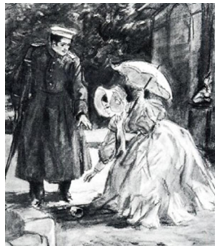
Pechorin And Princess Mary in
Lermontov’s A Hero Of Our Time (1839.)[12]
“My god, mademoiselle! Maybe I love you, maybe not! I don’t know, really! Who can remember all the passions of last winter! A man in love must kill time and not reason—do as I do, and you will be fine!”
Katerina shuddered, and in the midst of a thousand people, tears flowed from her eyes like a stream, and Lermontov laughed. Katerina did not go out for a month, except the church opposite her house, but even there she cried so much that the priest came up to her several times to ask the reason.
 Mikhail Yuryevich Lermontov.
Mikhail Yuryevich Lermontov.
At this time Katerina received an anonymous letter, a piece of art, supposedly from an unknown person, where Lermontov was described in the blackest colors. The letter said that he had seduced an unfortunate woman before and that the same fate awaited Katya. “He has the art of diabolism to repay prestige,” the letter stated, “he is a demon.” Katerina recognized that it was Lermontov’s handwriting but kept silent. The strength of her love for the man who had so cruelly made a game of her could be judged by the fact that she defended him against criticism. At their first meeting in society after the incident, she was unable to turn away from Lermontov when he approached her.
“God, how you have changed!” said Katerina. “What kind of evil could erase your beautiful colors?”
He looked at her with sympathy, and a spark of life crept into her soul.
“Will you give me permission,” Lermontov said, “I have to speak to you!”
Katerina forgot everything! She gave herself up to the hope that perhaps it was a test, a heavy dream, and from now on everything would pass. When it was time to dance the mazurka she sat down next to him with excited anticipation.
“Well, don’t you like what you’ve done? That’s and he began to count some of her acquaintances, with caustic ridicule at her expense.
Katerina did not go out again, and in the spring of 1833, she went to Moscow to attend the wedding of her cousin, Evdokiya Sushkova, to Count Andrei Rostopchin. While there, she met Vereshargina. The ladies were friendly with each other and had maintained correspondence, so Vereshargina knew all about Katerina’s sad affair. One day Katerina arrived early to see Vereshargina, going straight to the latter’s room while her hostess was busy in the drawing room receiving an important relative. Katerina saw an open box overturned on the table, with a pile of letters spilling out of it. She saw her name in a letter written in all-too-familiar handwriting. The letter said:
Don’t worry, my lovely cousin. [Aleksei] will never marry Miss Sushkova. I played a double role, which succeeded perfectly, and Miss Sushkova’s coquetry is well punished. She is so blackened in [Aleksei’s] eyes that he only feels contempt for her, and by dint of my flattery, I managed to turn her head and inspire in her a passion that bothers me. It won’t be so easy for me to get rid of her, but our goal is fulfilled. As for Miss Sushkova, come what may!
Only then did Katerina understand that the prince’s relatives, Vereshargina and her mother, living with him at his expense, did not want him to marry at all—especially not to a girl without a fortune.
When Vereshargina returned, Katerina showed her the letter.
“You see, I can expose your meanness,” said Katerina. “I can meet with the prince tomorrow and explain your behavior to him. I can triumph over you, but I would rather despise you and prove that there are noble feelings in the world that you have forgotten!”
Aleksei Aleksandrovich courted her again, but Katerina was cold towards him.
That was the end of it, but her love did not end. Katerina, though fully aware of Lermontov’s ignobleness, still loved him yet. Two years had passed since that story, but Katya could not force herself to meet Lermontov indifferently. In the rare meetings they had, he talked to her, and danced as if nothing had happened!
Helena Andreevna saw it herself several times and was amazed by Katerina’s behavior. “Of course, there is no accounting for taste,” Helena Andreevna thought, “but at least he was right when he said that he resembled Satan. Exactly like a little devil, with two coals instead of eyes, black, curly hair, and in a red jacket, no less!”[13]
Helena Andreevna cared little for these society gatherings, for society was cruel. The title they gave her, “femme-auteur,” she found disgusting, and the slander and trouble it brought her was overwhelming. No one seemed to understand that she, with a quill in her hand, in her everyday life at home, was a dual being. This nasty name gave her one benefit, however, and that was that all “good people” lamented her originality. When she wore a black dress to five balls that season, society thought it was the “author’s originality,” and no one suspected that she simply could not afford ball gowns. When she was so bored at one ball that she fell asleep in the powder room that, too, was attributed to the “author’s originality.”[14]
-
- NOVOROSSIYA
- The Arbiter Of Europe’s Destiny.
- The House Dolgorukuy
- Madame Krüdener
- Ekaterinoslav
- The Arabat Arrow
- The Mystery Of General Inzov
- The Doukhobors
- Pushkin
- Chuguev Military Settlement
- “The Blessed”
- The Decembrists
- Penza
- Independence
- Last Words Of Samuel Khristianovich Kontenius
- “Amid Coffins And Desolation”
- Rusalka
- Dead Souls
- Secret Passages
- Astrakhan
- Nevsky Prospekt
- Kalmyk Ulus
- Love And Ambition
- Duellistes
- Pyatigorsk
- A Heroine Of Our Time
- Winter Palace
- Zeneida R-Va
- Steppes
- Letter To Natalya
- Fire And Ice
SOURCES:
[1] Nekrasova, E. S. “Helena Andreyevna Hahn (1814-1842): Part I.” Russkaia Starina. Vol. LI, No. 8 (August 1886): 335-354; Nekrasova, E. S. “Helena Andreyevna Hahn (1814-1842): Part II.” Russkaia Starina. Vol. LI, No. 9 (September 1886): 553-574; Zhelikhovskaya, Vera Petrovna. “Helena Andreyevna Hahn (1835-1842.)” Russkaia Starina. Vol. LII, No. 3 (March 1887): 733-766.
[2] Such “ghost ballets,” like Giselle (1842,) became popular after Robert le Diable (1831.)
[3] In the fifteenth century Lydgate translated from the French a work called “La Danse Macabré.” On the title page the poet states that the dance of “Machabree” is vividly expressed and shows the state of man and “how he is called at uncertain times by death and when he thinketh least thereon.” The old French word Macabré first appeared in 1376 in Jean le Fèvré’s Respit de la Mort in which the author claims to have written a work called “La danse Macabré.” The Oxford Dictionary stated that the etymology of the word was obscure but drew attention to the fact that this name for the “Dance of Death” was popularly associated with the history of the Maccabees; “La danse des Macchabées” being a favorite allegorical representation of the Middle Ages of the seven Maccabee brothers and their mother. In Jacob Grimm’s Teutonic Mythology (1835) it was suggested that the word was derived from the Arabic maqabir (graves, tombs,) the plural of maqbar (tomb, cemetery,) from the verb qabar (to bury, inter,) so that “La Danse Macabré” would mean “the dance connected with the tombs.” From this Arabic maqabir were derived two words which could still be heard in the Iberian Peninsula at the time, namely the Portuguese almocávar (a cemetery) and Spanish macabe (a name for cemeteries in Almeria.) In Tripoli the Arabs still called the cemetery outside the town maqâbir. The cognate of the Arabic word appears in the Hebrew Bible in the name of the station in the wilderness called “Kivrot Ha-Ta’avah,” explained in the margin as “the graves of lust.” [Palmer, Abraham Smythe. Folk-etymology: A Dictionary Of Verbal Corruptions Or Words Perverted In Form Or Meaning, By False Derivation Or Mistaken Analogy. George Bell And Sons. London, England. (1882): 487; Mathew, A. L. “The Dance Of Macabre.” The Academy. Vol. LXXI, No. 1,808. (December 29, 1906): 664.]
[4] Hahn, Helena Andreyevna. The Complete Works Of Zeneida R-Va: Vol. I. N. O. Mertz. St. Petersburg, Russia. (1905): 210-299. (“The Medallion.”)
[5] Lermontov, Mikhail Yuryevich; (tr.) Parker, Martin. A Hero Of Our Time. Foreign Languages Publishing House. Moscow, Russia. (1957): 85.
[6] Ibid, 86.
[7] Zhelikhovskaya, Vera Petrovna. “M. Yu. Lermontov And E. A. Sushkov In Letters To E. A. Hahn.” in Sushkova, E. A. Notes (1812-1841.) Academia. Leningrad, Russia, Soviet Union. (1928): 297-305.
[8] Vatsuro, V.E. “Lermontov, Mikhail Yuryevich.” (ed.) Nikolaev, P. A. Russian Authors Biobibliographical Dictionary: Vol I. Prosveshchenye Publishers. Moscow, Russia. (1990.)
[9] Nekrasova, E. S. “Helena Andreyevna Hahn (1814-1842): Part II.” Russkaia Starina. Vol. LI, No. 9 (September 1886): 553-574.
[10] Vickery, Walter N. M. lu. Lermontov: His Life And His Work. Verlag Otto Sagner. München, Germany. (2001): 36-37.
[11] Ibid, 40.
[12] Lermontov, Mikhail Yuryevich; (tr.) Parker, Martin. A Hero Of Our Time. Foreign Languages Publishing House. Moscow, Russia. (1957): 94.
[13] Zhelikhovskaya, Vera Petrovna. “M. Yu. Lermontov And E. A. Sushkov In Letters To E. A. Hahn.” in Sushkova, E. A. Notes (1812-1841.) Academia. Leningrad, Russia, Soviet Union. (1928): 297-305.
[14] “Letter From E. A. Hahn To Natalya P. Dated January 10, 1839. [Kamenskoye Village, Ekaterinoslav Province.]” [Preparation of the text and comments by A.D. Tyurikov. Bahmut Roerich Center. Originally published in: Gershenzon, M.O. “Russian Woman Of The ‘30s.” Russian Thought. Vol. XII, C. 55 (December 1911.)


